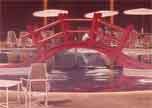Daniel Douke
dal 27/10/2006 al 15/12/2006
Segnalato da
27/10/2006
Daniel Douke
Luckman Gallery, Los Angeles
Comfortably occupying the gap between painting and sculpture, Daniel Douke (pronounced Doo-KAY) is best known as a painter of boxes. He does not construct boxes (as a sculptor would), nor does he illustrate their form (as a painter would). Curated by Mat Gleason.

curated by Mat Gleason
Comfortably occupying the gap between painting and sculpture, Daniel Douke
(pronounced Doo-KAY) is best known as a painter of boxes. He does not
construct boxes (as a sculptor would), nor does he illustrate their form
(as a painter would). Rather he renders--to perfection--every nuance of a
box in a manner that could be called photorealistic. . .if photography
ever catches up to Douke! His uncanny eye for detail and dextrous
precision combine to recreate every perceivable imperfection among the
mundane details and geometry of the heretofore ordinary cube.
In “Endless Instant," a 30-year career retrospective, we see how his
penchant for presenting the world as it exactly exists has been the theme
in all of his work. In the mid-1970s he garnered notoriety for
photorealistic renderings of Southern California swimming pools. In one
large untitled 1973 painting of a Reseda pool, the perspective is from the
surface of the water looking toward patio furniture. Every detail
practically down to the last atom is lined up and crisply on view. The
sensation of chlorinated summer afternoons absorbs the viewer, lifting
Douke’s realism beyond mere careful observation. It borders on the
producing of reality. And herein is the seed for his investigations beyond
the picture plane. The need to recreate rather than depict reality took
the artist toward the object. But an impish sense of humor compelled Douke
to make paintings that are neither window into the world nor sculptural
statement.
And so, there, mounted on the wall is a medium sized cardboard box.
Mid-seventies minimalism at its most insistently ordinary? Donald Judd’s
specific object made for the masses in some Marxist melodrama? A
Duchampian snark on everything sacred about gallery walls? Look closer.
The tape, the address label, the insignificant scuffs and dings from
delivery, shipping and handling--they are all painted on. The box is not
even cardboard, it is canvas. This is how Douke stayed sane inside the
70’s insanity of art world postmodern babble. He made realistic artworks
of the grittiest, realest objects of his time.
In the 1980s, with this deft talent refusing to play to the art world’s
desire for a one-trick pony, Douke made large object-paintings that
resembled massive shards of discarded steel. Again, the eye is fooled and
the lazy Duchampian scolded--as the artist’s oil on canvas simultaneously
mimicked Richard Serra and the detritus of industry. But it was his love
of a fine cigar that brought him a big career boost. In the early 1990s,
he began creating large scale reproductions of cigar boxes in un-scuffed,
pristine condition, complete with faithful renderings of the baroque
scenes on display in the center of the lid, be they a mysterious sheik for
the “Sultan" brand of rolled tobacco, or the triumphant cherubs
celebrating “La Gloria Cubana" cigars. A waiting list for these works
developed. And in the midst of this stage of hyper-production, Douke took
breaks to work on small floor pieces of scuffed and chipped Apple Computer
boxes. The I-Mac had just hit, and its array of sumptuous colors gave
high-tech its own fashion statement. Soon the Dot-Com millionaires were in
line with the smoking investment bankers. Douke had managed to make a
beautiful, seductive object that had a conceptual rigor, and made them
work together.
Douke’s realism is in the long art historical lineage of precision
engineers, and yet his choices of subject matter satisfy the basic
criteria of many schools of artistic theory. Few artists could be
construed as Pop, Minimal, late-Dada, photorealist or trompe l’oeil, but
this artist pleasantly works the room, cozy with them all. His work exists
at the oft-theorized intersection of eye, hand and mind. While three
generations of art world denizens have been yammering about the
possibilities of these three working together, Douke has been manifesting
the notion into reality.
[Note—Douke’s new paintings are also the subject of a current exhibition
at Rosamund Felsen Gallery, Santa Monica—Ed.]
Opening: October, 28, 2006
Luckman Gallery
5151 State University Drive - Los Angeles
Monday - Thursday and Saturday, 12:00 - 5:00 p.m.



